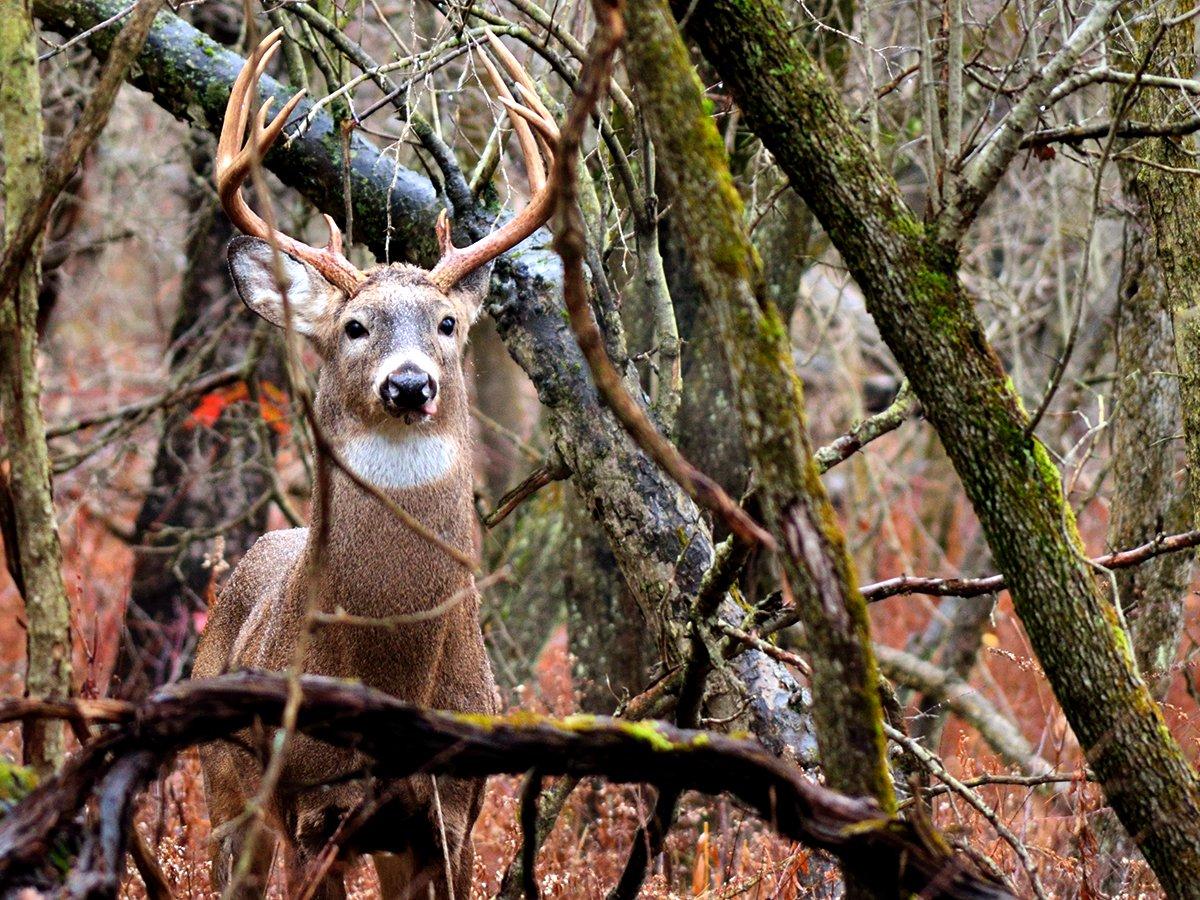Cattail sloughs, cedar draws, and tangled thickets might be your ticket to arrowing Mr. Big
Whenever I hunt, scout or look for shed antlers on public lands, I'm always amazed by how so many humans think alike. I can't count how many times I've found boot tracks where I planned to hike or a treestand hung where I'd planned to hang one myself. Most hunters think somewhat alike, and that concentrates a lot of hunting pressure in what appear to be the obvious hotspots on your mapping app. Often, mature bucks feel the pressure influx and avoid these areas during daylight.
If you want to be consistently successful hunting big bucks on public land, you need to outwork everyone else. If that means walking 1 mile deep instead of half a mile, do it. But you also need to think differently. In other words, don't always hunt the obvious cornfield or river bottom. If you're tired of seeing more hunters than big bucks, consider shifting your tactics to places like this.
Cattail Sloughs
While hunting North Dakota in 2021, my wife and I pinpointed a 150-class buck on a pattern from bedding in a cattail slough to feeding in a standing cornfield. Many eastern and midwestern hunters accustomed to timber would've driven right by the parcel this buck was living on because there aren't trees for treestands, but the place was actually number one on my list from virtual scouting. And it didn't disappoint, as we saw three other big bucks, including an even larger one. We encountered the target buck on the first three afternoons, but each time he narrowly averted me.
Tactics for hunting in cattail sloughs depend on the period of the season that you're hunting. During early season, try glassing from a distant vantage point as we did. Try to peg a mature buck's pattern — note where he enters and exits the cattails — and then move in when the wind is right and hunt from the ground in whatever cover is available.
During the rut, consider hunting all day along the slough's downwind edge. Or, pop in and out of sloughs, rattling at the edge and waiting half an hour before moving to another slough. If cover is sparse, consider a bow-mounted decoy from Ultimate Predator (use with caution and never where archery and firearms seasons overlap) as coverage with the added element of attraction. This yielded a 20-yard shot for me on a bruiser South Dakota 10-pointer in 2020.
In habitat where cattail sloughs are common, don't overlook them. These hide more mature bucks than most realize. You just have to be flexible with how you set up. In some instances, there might be only one large tree along the edge of a cattail slough, and deer very well could travel by it. In other cases, there aren't trees, and you'll be faced with crafting a ground ambush.
(Don't Miss: 10 More Deer Hunting Myths Debunked)
Thickets
Often, thickets provide exceptional security and a tactical escape in the event of danger. That's why big bucks love them. In traditional timbered habitat, these aren't easily identified via satellite imagery. You'll have to rely on your spring scouting to find them and then add them as markers on a mapping app. On the prairies in states like Kansas or South Dakota, a mapping app is the only way to effectively locate thickets without tromping around because they're not usually visible from roadways.
When thickets occur in the timber, an effective way to hunt them is to get elevated in a treestand or saddle on the downwind edge to capitalize on bucks exiting the thicket or swinging along the downwind side to scent-check it. In an isolated thicket amongst otherwise open habitat, I suggest distant scouting for early season, similar to what I suggested for cattails. But, I prefer to hunt them actively from the ground — visibility and shooting coverage at ground level are usually superior to an elevated ambush — during the rut.
I did this in Iowa in 2019, calling in three different bucks and arrowing one of them at 15 yards without him knowing I was there. There were hands-and-knees operations in order to negotiate through the thickets, and clear shooting visibility was constantly 15 yards or less. Interestingly, the thickets I hunted were along roadways and in close proximity to parking lots. Nobody was hunting in them because there were no suitable trees for stands.
Switchgrass
Tall switchgrass fields provide excellent wildlife cover, and they provide refuge for bucks to mature. Often bordered by timber or at least a shelterbelt, your best bet is typically to hunt the edges with your wind blowing away from the grass. It's the safest bet for stand access. Plus, the elevated ambush will give you a better view along the edge and out into the switchgrass. In contrast, hunting from the ground can be tricky, as the grass will almost always obstruct the animal to an extent, thereby impeding an ethical shot.
When hunting along a switchgrass edge during the pre-rut, rattling and grunting can pull a buck from the seas of grass to within shooting range. During the rut, bucks might escort does to the switchgrass and lock down with them there until they breed. So, it can be an effective place to hunt during every rut phase. Consider hunting from a saddle, which will allow you to hunt from a wider variety of trees than will a treestand.
(Don't Miss: How to Read Rub Lines)
Cedar Draws
During a Kansas bowhunt in 2020, I identified a series of draws dotted with scrubby cedars in prairie habitat that bordered private agricultural lands using my mapping app. On day one of the hunt, I decided to pick it all apart as if I were mule deer hunting. I'd approach the downwind edges of the draws, arrow nocked, acting as if each draw held deer. Slowly, I'd rise and peer into the draws.
At noon, I bow-killed a 151 6/8-inch buck that I'd caught following a doe. None of the draws I'd stalked up to had any possible treestand ambushes, and so they probably had seen little to no hunting pressure. I also killed that buck 1 1/2 miles from the road, thereby reiterating the premise of this article: outwork and think differently than everyone else.
Of all the nasty places we've covered, cedar draws intrigue me most. I can adjust my route according to the wind direction, and spend the day slinking around and picking apart the terrain. However, I've also assumed stationary ambushes when I find that all whitetail trails lead to a common intersection. I've sat next to a cedar, but I've also hung a stand 5 feet off the ground in one. That non-glamorous setup nearly produced a public-land monster, probably nearing 170 inches. Here again, I thought differently by hanging a treestand in virtually a bush. The buck approached from an unexpected direction, though, and the doe he was following caught my wind, thwarting what would've been a 30-yard shot.
Cedar draws all across whitetail country can be dynamite if you can find viable ways to hunt them. Bucks love the security they offer and typically feel safe on their feet during daylight.
(Don't Miss: 5 Best Stand Setups for Pre-Rut Bowhunting)
Get Nasty, Find the Big Bucks
We've been taught for decades that obvious food and terrain features make great hunting locations. Sometimes they do, but on public lands, other hunters commonly focus on those areas, and the pressure influx causes bucks to seek refuge in less-glamorous haunts. Whether it's a thicket along the road that nobody hunts or a distant cedar draw that no one is willing to hike to, some of the best public-land bucks can be found in nasty places. Dive in and see.










